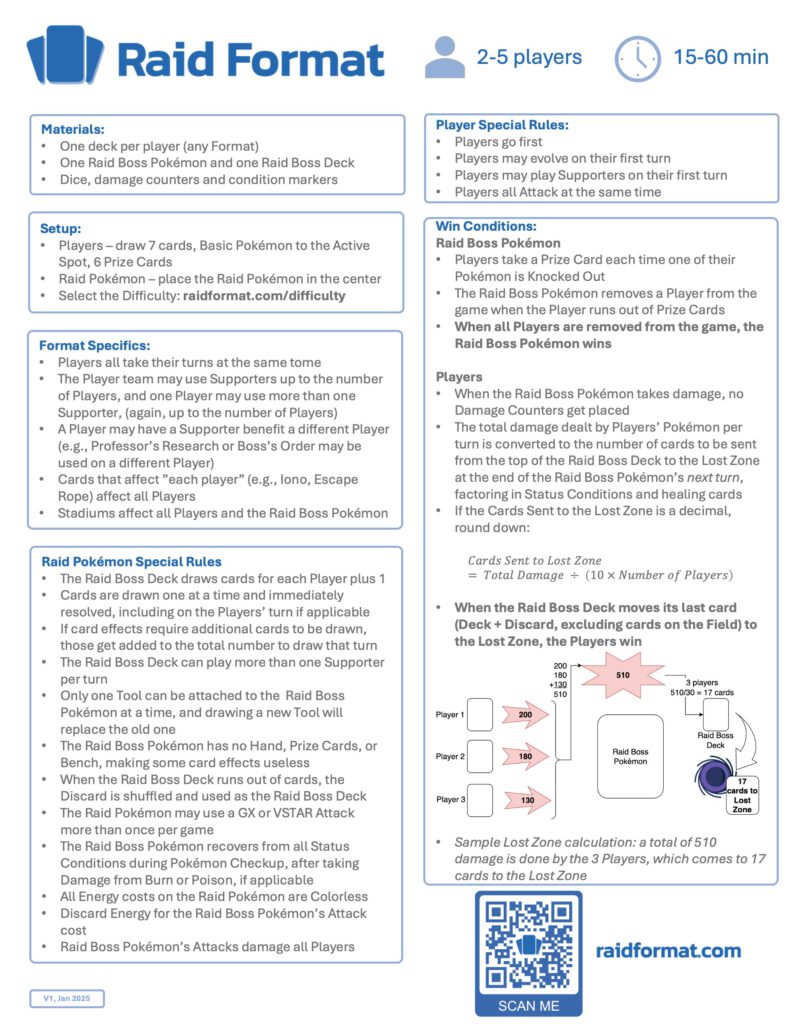Raid Format is a new way to play the Pokémon TCG, which is classified as an advanced format in the official Pokémon TCG Alternative Play Handbook, released in July 2022.
Battles are cooperative against a Raid Boss Pokémon, where the goal is to mill the Raid Boss deck into the Lost Zone (i.e, remove cards from play permanently), determined based on damage output. Players take their turns at the same time, and some cards can impact all players, making communication and timing critical!
We disagree with some of the official rules for this format from the Alternative Play Handbook, and propose some changes to the format. We highlight changes we suggest on this page, and also include the official ruling in brackets.
We have made a Rule Sheet to keep alongside you when playing! This would be great for a Local Game Store to have printed when running a Raid Format night!
What you need to play:
-
Each Player will need a 60 card deck. Decks from any format (e.g., Standard, Expanded, etc.) can be played, but note that success in the game is based on overall damage output, so you may deal more damage, and thus have more success with newer cards (i.e., Sword and Shield onwards).
- Technically, decks from formats such as Gym Leader Challenge could be played, but might be more challenging, as total HP and damage output would both be less. (See FAQs.)
- A Raid Boss Pokémon
- A Raid Boss Deck
Raid Boss Pokémon
The Raid Boss Pokémon is usually represented by a Jumbo Pokémon card, the ones included in Pokémon box sets or special collections, such as those below:
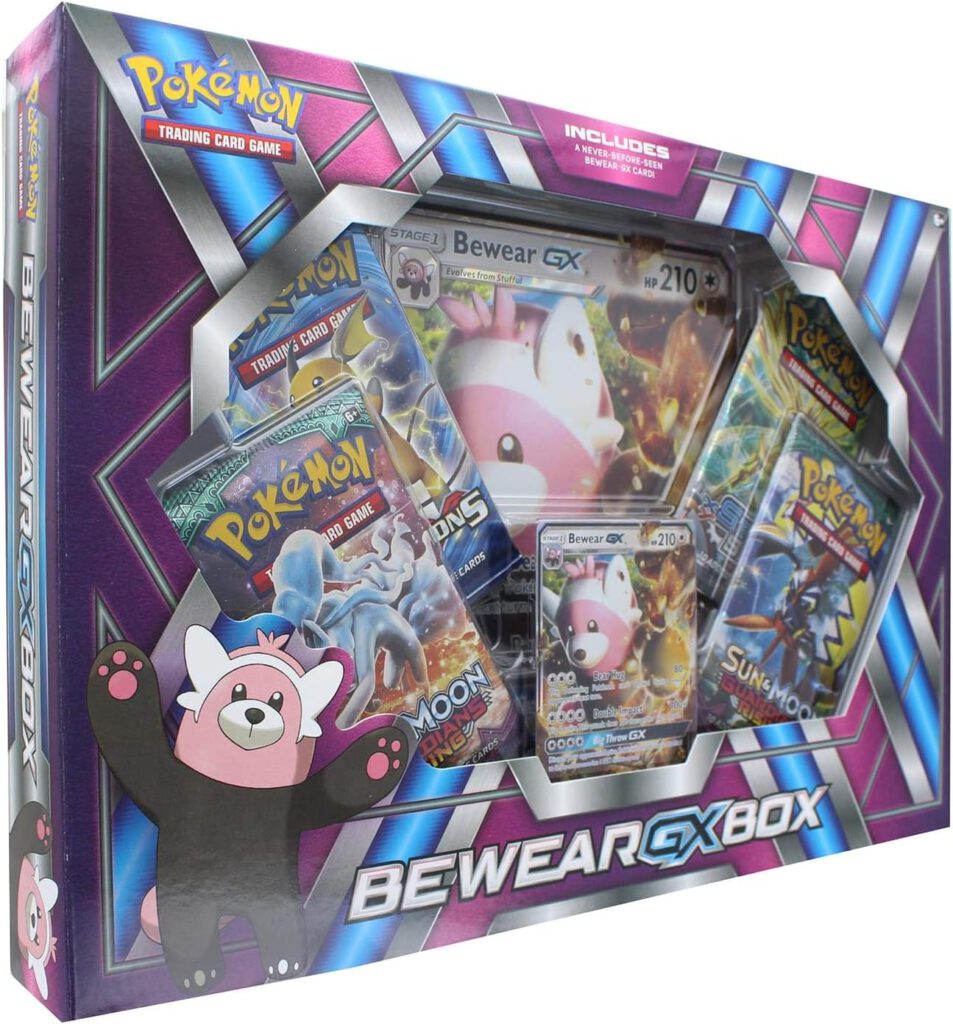
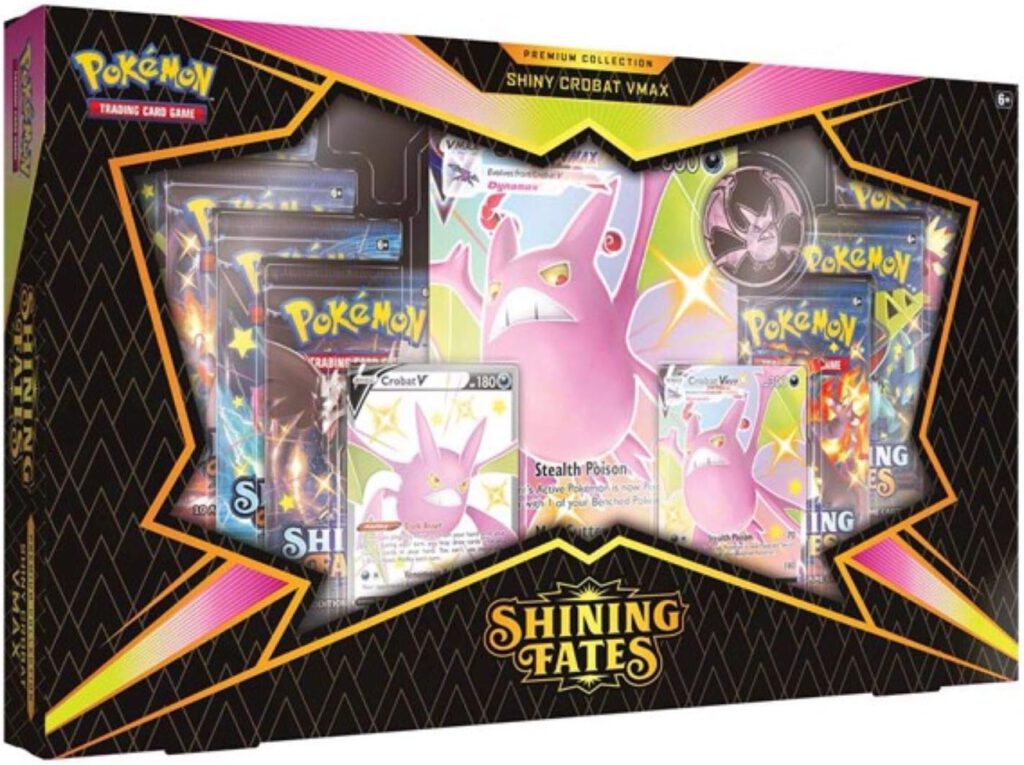

Raid Boss Deck
We provide details on what makes a good Raid Boss Deck here, but this is a 60 card deck with a mix of Trainers and Energy that allow the Raid Boss Deck to draw, and disrupt the Players. We provide some sample deck lists as well.
Rules
Difficulty
We have a dedicated page to help the Players and the Raid Boss choose how difficult to make the game. This mainly involves differences in how to interpret and resolve card effects, and how the Raid Boss Pokémon’s attack is determined, either randomly, or chosen by the Raid Boss.
Game Flow

The game flow is very similar to a standard game of the Pokémon TCG. Players go first, and may play Supporters and Attack on their first turn. The Raid Boss may also attack in its first turn.
Players’ Turn
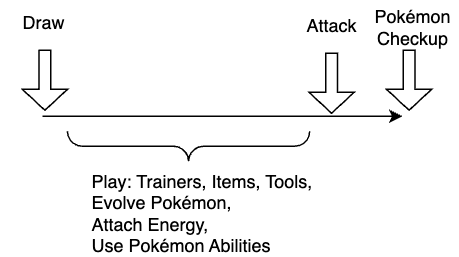
The Players’ turn looks very similar to a usual TCG game as well, where Players can play Trainers, Items, Tools, Evolve, attach one Energy from the hand, and use Abilities.
Between all Players, they may play Supporter cards up to the number of Players. If there are four Players, between all four Players, they may play up to a total of four Supporter cards per turn. This may be shared between all the Players, or one Player may play four Supporter cards. Supporter cards may be played to benefit another player, such as using a Professor’s Research on a different Player.
Some cards, like Iono, affect all Players, and the effect of Iono must be resolved for all Players at the same time. This makes it important to check with other Players before playing such a potentially disruptive card, and can make some turns look like the below:
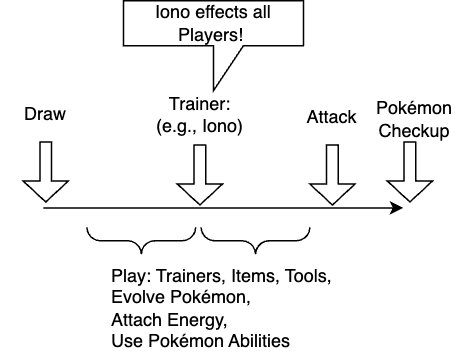
Damage Calculation
Damage works differently in the Raid Format, as the win condition for the Players is not to Knock-Out the Raid Boss Pokémon, but to have all of the Raid Boss Deck and Discard sent to the Lost Zone. The total damage dealt by Players’ Pokémon per turn is converted to the number of cards to be sent to the Lost Zone.
Cards Sent to Lost Zone = Total Damage ÷ (10 × Number of Players)
This calculation can get tedious. We have a Damage Calculator you can use on this page.
Assume a Raid Boss game has three players, whose Active Pokémon deal 200, 180 and 130 damage each.
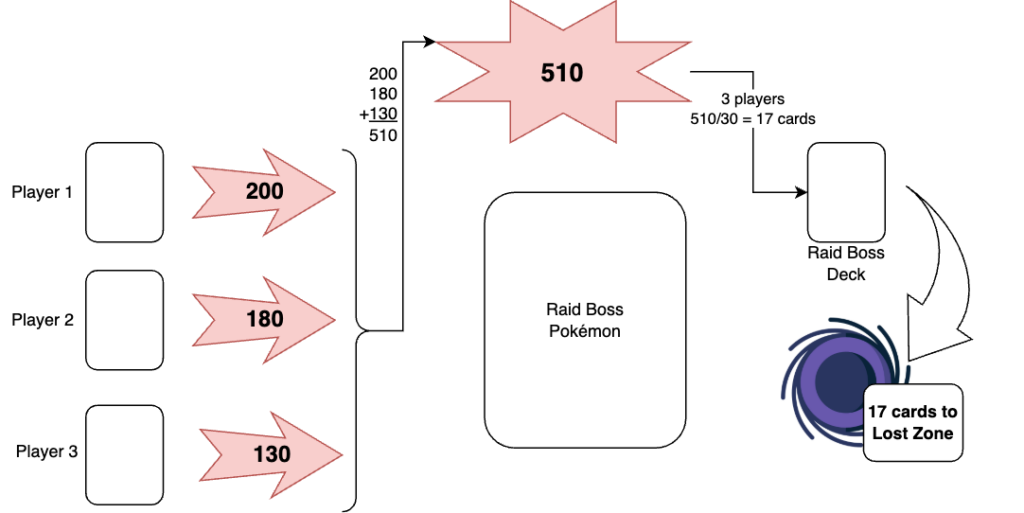
Cards Sent to Lost Zone = (200+180+130) ÷ (10 × 3) = 510 ÷ 30 = 17 cards
That damage gets added together, and divided by 30, or 10 × the number of players. This number of cards, which equals 17, gets sent to the Lost Zone. If the number is a decimal, round down.
If 4 players dealt a total of 510 damage, 510/(10 × 4) = 12.75, rounded down to 12, cards are sent to the Lost Zone.
The Raid Boss Pokémon may be affected by a Status Condition, but only for one turn, as it heals during Pokémon Checkup.,
Cards are sent from the Raid Boss Deck to the Lost Zone at the end of the Raid Boss Pokémon’s next turn! This is to account for healing cards used during their turn.
If there were only 5 cards remaining in the Raid Boss Deck, the Raid Boss Deck’s Discard would be shuffled and used as the new Deck. (Note: the Handbook states that this may only occur once, but we allow it to happen as often as needed. See “Decking Out” below.)
We suggest not considering Weakness or Resistance in Raid Format.
Raid Boss Pokémon’s Turn
The Raid Boss draws a card for every Player, and one for themselves. For a three Player game, the Raid Boss Pokémon would draw four cards. The Raid Boss draws and then resolves the effects of cards as they draw them.
Raid Boss Decks are often designed to cause disruption for Players.
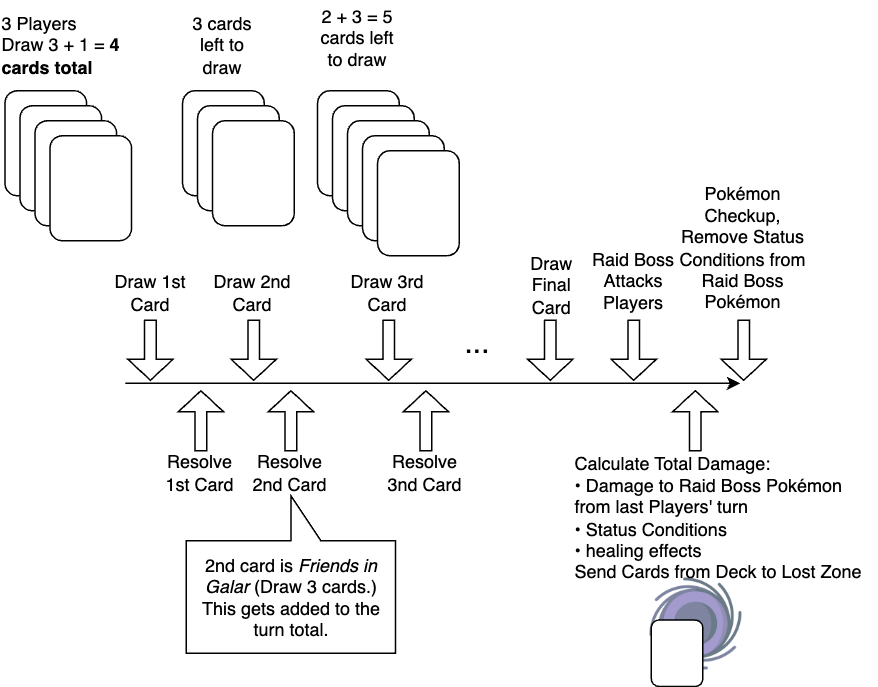
It’s important to keep an accurate tally of how many cards need to be drawn from the Raid Boss Deck each turn. Trainers which increase the number of cards drawn add to the tally (see above).
- Tools are immediately attached as they are drawn. Raid Boss Pokémon may only have one Tool attached at one time, and existing Tools are discarded.
- Stadiums are activated as soon as they are drawn. Only one Stadium may be in play at a time, and Stadiums effect each Player and the Raid Boss Pokémon.
- Energy cards are attached to the Raid Boss Pokémon as soon as they are drawn. This can mean that more than one Energy is attached per turn.
- Supporters are resolved as soon as they are drawn.
- Cards that require a selection should be resolved according to the difficulty selected.
Sometimes the Raid Boss must draw during the Players’ turn. If so, cards are drawn and resolved in turn on the Players’ turn. The Raid Boss does not form a “hand” of cards at any point, as the cards drawn are played immediately.
If the Raid Boss Deck runs out of cards, the Discard should be shuffled and used at the new Deck (see “Decking Out” below).
Raid Boss Attacks
The Raid Boss attacks all of the Players’ Active Pokémon at the same time. An attack is selected according to the difficulty decided upon at the beginning of the game. The Raid Boss Pokémon’s attack costs are all considered Colorless, meaning any Energy (Basic or Special Energy) can be used to pay the attack cost. The Energy cost of the attack is paid by discarding Energy cards, discarding the fewest number of cards possible.
When a Player’s Pokémon is knocked out, that Player takes one or more Prize Cards. When that Player takes their last Prize Card, they are removed from the game. (Note: the Handbook states that a player is only removed when that player must take a Prize Card, but are unable to, but we disagree, and think it should be when the last Prize Card is taken.) When all players are removed from the game, the Raid Boss wins.
We suggest not considering Weakness or Resistance in Raid Format.
Status Conditions
Players’ Pokémon may be affected by Status Conditions like a normal game. The Raid Boss Pokémon is healed of all Status Conditions at the end Pokémon Checkup each turn.
When affected by a Status Condition, we will add the amount of damage the status condition will afflict during Pokémon Checkup (10 damage for Poison, 20 damage for Burn) when calculating the total damage per turn.
In the rare case the Raid Boss Pokémon ends their own turn with a damaging Status Condition, place damage counters on the Raid Boss Pokémon, and include that damage the following turn when calculating the total damage.
Damage to the Raid Boss Pokémon
At the end of the Raid Boss Pokémon’s turn, cards are sent from its Deck to the Lost Zone based on the total Damage it took, considering any Status Conditions it had, and subtracting from that amount any damage it healed. (Our Damage Calculator can help you with all of this math!). If Players did sufficient Damage to mill all of the cards from the Deck and Discard to the Lost Zone, but the last Player(s) took their final prizes on the same turn, we consider that a win for the Raid Boss.
Win Conditions
Players
- When the Raid Boss Pokémon takes damage, Damage is added up, divided by 10 × number of players, then that many cards are sent from the Raid Boss Deck to the Lost Zone. If the math results in a decimal, round down. (Note: the Handbook states that any remaining damage should be placed on the Raid Boss Pokémon, but makes the math too complex, and we ignore this rule.)
- When the Raid Boss Deck runs out of cards, the Discard is shuffled, and used as the Raid Boss Deck. (Note: the Handbook states that this can only happen once per game, but this puts an unnecessary artificial cap on the part of the Raid Boss)
- When the Raid Boss Deck can’t move any cards to the Lost Zone (i.e., the Raid Boss’ deck and discard are all in the Lost Zone), the Players win.
Raid Boss
- When a Player’s Pokémon is Knocked Out, the Player takes the appropriate number of Prize Cards (e.g., 2 for a Pokémon ex, 3 for a Pokémon VMAX).
- A Player is removed from the game when they take their last Prize Card. (Note: the Handbook states that a player is only removed when that player must take a Prize Card, but are unable to, but we disagree.)
- When all players are removed from the game, the Raid Boss wins.
Changes in Raid Format
- Players always go first.
- Players all take their turns simultaneously.
- Players may play Supporters and Attack on their first turn.
- The Raid Boss Deck doesn’t draw any additional cards if a Player mulligans.
- Players may Evolve their Pokémon (including using the effect of Trainers that benefit evolution, such as Rare Candy or Technical Machine: Evolution).
- The Players may use Supporters up to the number of Players. If four players are playing, a total of four Supporter cards may be played per turn.
- Supporters can be shared between players, or all used by one player. One Player may use more than one Supporter, but the total number of Supporters may not be greater than the number of Players.
- Supporter cards can benefit another player, such as Professor’s Research being used to help another player draw cards.
- Cards that affect ”each player” (eg, Iono, Escape Rope) affect all Players, and the Raid Pokémon if applicable.
- The Raid Boss doesn’t have a “hand,” and any cards that target their hand don’t work. Cards that make the Raid Boss put cards into their hand are drawn and played immediately,
- The Raid Boss Pokémon’s Attack Energy costs are Colorless, and Energy cards are discarded from the Raid Pokémon to pay the Attack Energy cost.
- When a Player’s Pokémon is Knocked Out, that Player takes a Prize Card, and losing all Prize Cards contributes to game loss for the Players.
“Decking Out”
- If a Player runs out of cards in their Deck, they may continue playing the game, skipping their Draw. If their Deck gets replenished (e.g., from Super Rod), they must draw on their next turn.
- If the Raid Boss Pokémon runs out of cards for their Deck, they may shuffle their Discard to form a new Deck. (Note: the Handbook states that this may only occur once, but we allow it to happen as often as needed.)

